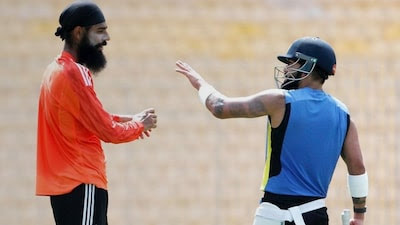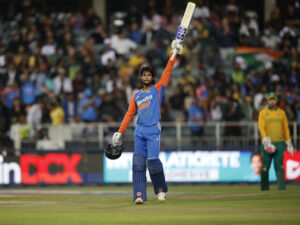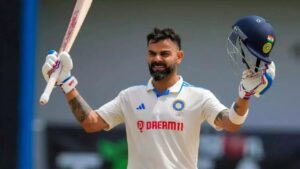
Virat Kohli’s Alleged Advice to Tamil Nadu Left-Arm Pacer Gurjapneet Singh Sparks Debate in Indian Cricket
In an incident that has set off a fresh round of debate in Indian cricket circles, Tamil Nadu’s young left-arm pacer Gurjapneet Singh recently found himself at the center of attention after revealing a piece of advice allegedly given to him by Indian cricket superstar Virat Kohli. What seemed like a well-intentioned piece of mentorship has unexpectedly ignited controversy, with fans and analysts divided over the message and its implications.
The Alleged Advice
During a recent interaction, Gurjapneet Singh reportedly stated that Kohli, known for his fiery attitude and unrelenting dedication to the game, had advised him to “focus more on pace and aggression” rather than relying heavily on swing or technical variations at this stage of his career. According to Gurjapneet, Kohli suggested that the key to success in modern cricket, especially in shorter formats, was to bowl consistently at speeds above 140 km/h and intimidate batsmen with raw pace.
While this advice may sound standard for pacers across the globe, it has stirred controversy in the Indian cricketing landscape for several reasons.
Debate Over Pace vs. Skill
Kohli’s advice has sparked a debate on the importance of speed in cricket, particularly in the Indian context. India has traditionally produced fast-medium bowlers who rely on swing, accuracy, and variations to outsmart batsmen. Legends like Kapil Dev, Zaheer Khan, and Bhuvneshwar Kumar built their careers around the ability to move the ball in the air and off the seam. Kohli’s supposed focus on raw pace over technical skill has raised eyebrows among purists, who argue that speed alone doesn’t guarantee success, especially in conditions that favor swing.
Former cricketers and commentators were quick to weigh in. Some criticized the advice, stating that young bowlers like Gurjapneet could lose their identity by abandoning swing, which has traditionally been one of India’s greatest bowling assets. Others warned that an overemphasis on pace could lead to unnecessary injuries, given the physical strain it places on bowlers, especially those still developing their game.
Kohli’s Vision for Indian Cricket
However, Kohli’s defenders argue that his advice reflects his broader vision for a more aggressive and physically dominant Indian cricket team. Since becoming captain, Kohli has consistently pushed for higher fitness standards, faster bowlers, and a more aggressive mindset on the field. He has often spoken about the need for Indian bowlers to compete with the likes of Australia, South Africa, and England, where fast, hostile bowling can dismantle batting line-ups.
Fans and analysts on this side of the argument believe that Kohli’s message to Gurjapneet was intended to push him to unlock his full potential. For them, the advice was not about abandoning swing but about adding the dimension of fearsome pace to his repertoire, making him a more complete and dangerous bowler in all conditions.
The Pressure on Young Cricketers
But this brings up another point of contention: the pressure placed on young cricketers by the words of stars like Kohli. Gurjapneet Singh, like many aspiring players, looks up to Kohli, and his every suggestion could carry an overwhelming influence. Some critics argue that not all players can, or should, mold themselves into the aggressive archetype that Kohli has championed. Every cricketer has a unique style, and forcing a particular approach might backfire, stifling the natural talent of players like Gurjapneet, who could be better served by focusing on their strengths.
This advice, in the hands of an impressionable player, could set a dangerous precedent. If young bowlers start prioritizing pace over swing without proper conditioning or understanding of their bodies, the risk of injury looms large. There have been multiple instances of promising young fast bowlers burning out early due to the physical toll of trying to consistently bowl at high speeds.
Kohli’s Influence: Positive or Overpowering?
The incident also raises the question of how much influence senior players should exert over younger talent. Kohli is known for his strong personality and leadership style, which has clearly worked wonders for his own career and for Indian cricket in many ways. However, the line between mentorship and overbearing influence can sometimes blur.
While some see Kohli’s advice as an attempt to shape a new generation of aggressive, fast-bowling Indian cricketers, others caution that his intense style may not be suitable for everyone. Young cricketers like Gurjapneet must navigate this fine line between heeding the advice of their idols and staying true to their own strengths and capabilities.
Conclusion
Virat Kohli’s advice to Gurjapneet Singh may have been meant as simple guidance to help the youngster succeed in a competitive sport, but it has opened up a broader conversation about the future of Indian fast bowling. Should the next generation of Indian pacers focus primarily on raw pace, or should they stick to the nation’s traditional strengths of swing and guile?
As with many controversies in Indian cricket, this debate reflects deeper tensions about the evolving identity of Indian cricket. Whatever the outcome, Gurjapneet Singh’s career trajectory will be one to watch, as he navigates the expectations placed upon him by the cricketing greats while striving to carve out his own unique path.






